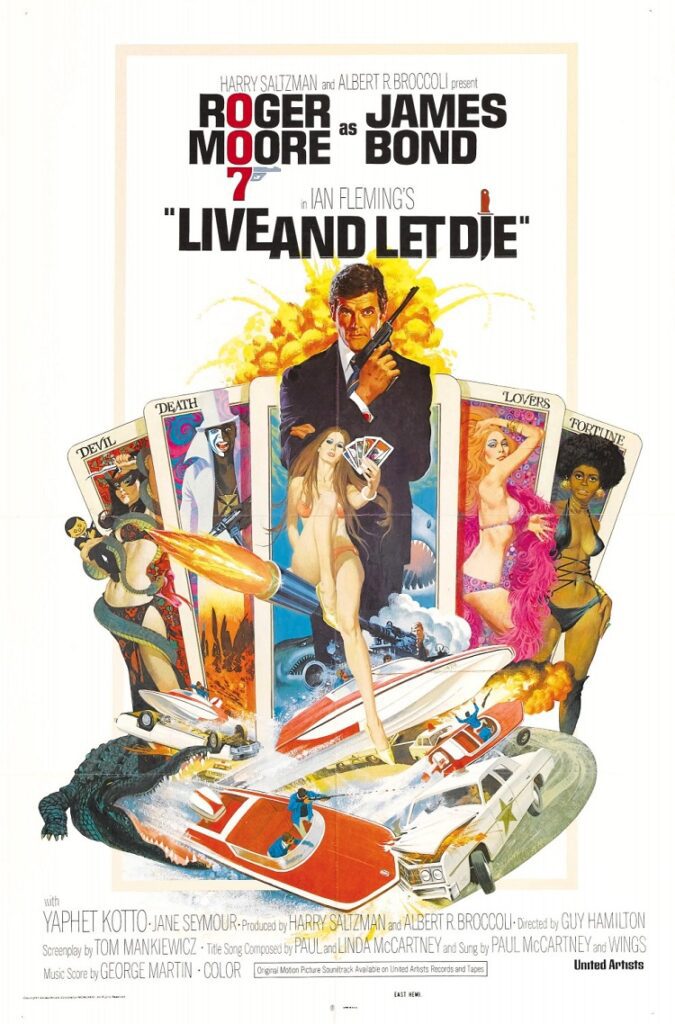
In the last 50 years, most people have seen at least one James Bond film. Mine happened in 1973 at the tender age of six. It wasn’t just my introduction to the world of James Bond, it was my welcome to the world of movies made for adults. While I would only dabble in this world the next few years – Jaws, Star Wars, and Smokey and the Bandit among them – these few films had a profound affect on my adult movie preferences. It’s why I like Shark Week, Comic Con, and movies the star guys with moustaches. It’s also why I love the spy genre.
Live and Let Die comes along at an interesting crossroads for the Bond franchise. It is the eighth film in the series but cinema and society had changed radically since the early films of the 1960s. The previous film, Diamonds Are Forever, was bordering on repetition of previous plots. Sean Connery declined to sign another contract, wanting to move on beyond the character. Roger Moore came on board with quite a bit of spy credibility from his years on The Saint. His version of Bond would become much more of the rich, playboy character than the ruggedly handsome and gruff Connery version.
My impression at the time was that this was an out of control and scary world. For a child raised on Disney versions of the world, this movie had drug smuggling, voodoo, boat chases, tarot cards and a coffin full of snakes. In a word, I was terrified and couldn’t turn away. The film was action from beginning to end and I can still vaguely remember the shock to my system this film was.
Today I’ve watched it another dozen times probably. I know it’s not my favorite of all the Bond films. It might not even be my favorite of the “Moore as Bond” films. But in the end, it might be the best example of a Bond film that you could show a new fan. It’s got all the touchstones that make this my favorite movie franchise.
The Bond films have made it 50 years because they adapt to reflect the society at the time of their release. Look at how this film reinvigorated the series that was languishing with Connery fighting the bad-guy-of-the-week type of villain. This film becomes more murder mystery than spy film as Bond tries to solve the murders of two British agents in the U.S. The plot revolves around drugs as much as it does Dr. Kanaga/Mr. Big. The film reflects the popularity of Blaxploitation films of the era with the setting in New Orleans and the Caribbean Islands, not to mention the great acting by Yaphet Kotto and the beautiful Bond Girl, Solitaire played by Jane Seymour. The film’s climax centers around a long speedboat chase in Louisiana where he is pursued by a State Policeman who would later be an influence for Jackie Gleason in Smokey and the Bandit.
You can’t mention this movie without talking about the music. Another deviation from the previous films proved to be a good move. The theme song by Paul McCartney and Wings brought an early Seventies rock connection to the film as opposed to the jazz artistry of Shirley Bassey in earlier films. And John Barry was not able to score this film, leaving it to George Martin who put a much more lively pop music stamp on the movie.
Live and Let Die was my first Bond. I hold it dear to my heart and defend it more now than ever. This isn’t the pinnacle of the Bond films. But it’s the necessary step to move the franchise forward. It showed us how the series would remain relevant into 2012. It wasn’t by telling simple spy versus evil megolomaniac villain trying to take over the world type of stories every time out of the gate. There’s more subltety in Moore’s performance. He’s lighter and a bit more comedic. He’s suave and doesn’t just rely on gadgets to get the job done. This film is the blueprint. Like Paul sings – “In this ever changing world in which we live in.”
Operation: BOND will return with The Man with the Golden Gun.